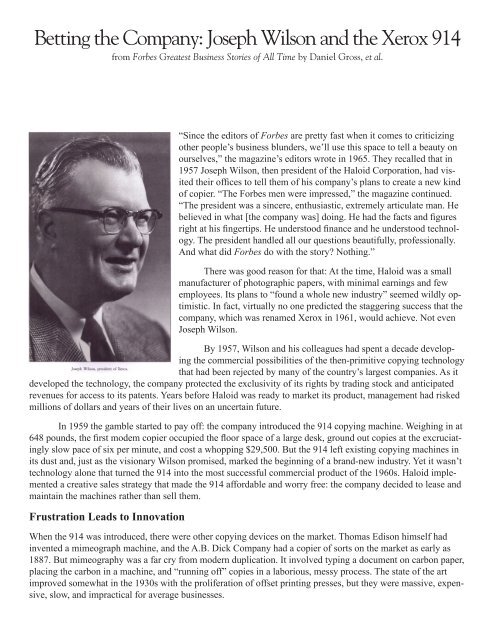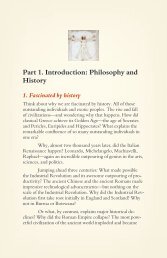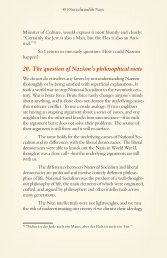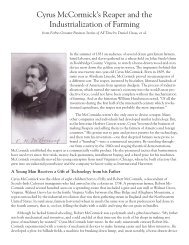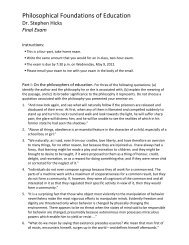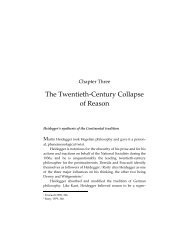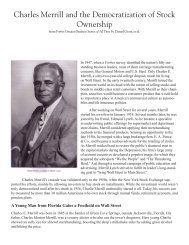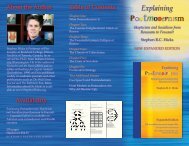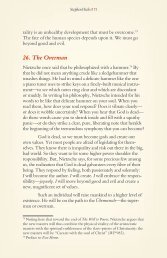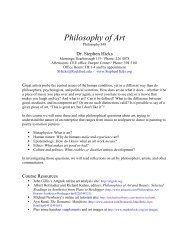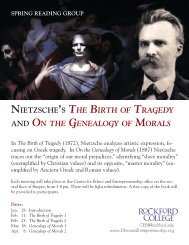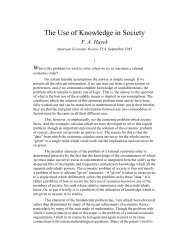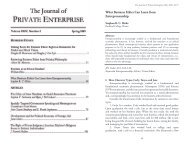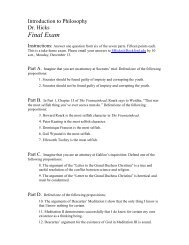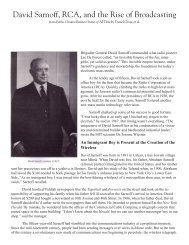Betting the Company: Joseph Wilson and the Xerox 914
Betting the Company: Joseph Wilson and the Xerox 914
Betting the Company: Joseph Wilson and the Xerox 914
Create successful ePaper yourself
Turn your PDF publications into a flip-book with our unique Google optimized e-Paper software.
<strong>Betting</strong> <strong>the</strong> <strong>Company</strong>: <strong>Joseph</strong> <strong>Wilson</strong> <strong>and</strong> <strong>the</strong> <strong>Xerox</strong> <strong>914</strong><br />
from Forbes Greatest Business Stories of All Time by Daniel Gross, et al.<br />
“Since <strong>the</strong> editors of Forbes are pretty fast when it comes to criticizing<br />
o<strong>the</strong>r people’s business blunders, we’ll use this space to tell a beauty on<br />
ourselves,” <strong>the</strong> magazine’s editors wrote in 1965. They recalled that in<br />
1957 <strong>Joseph</strong> <strong>Wilson</strong>, <strong>the</strong>n president of <strong>the</strong> Haloid Corporation, had visited<br />
<strong>the</strong>ir offices to tell <strong>the</strong>m of his company’s plans to create a new kind<br />
of copier. “The Forbes men were impressed,” <strong>the</strong> magazine continued.<br />
“The president was a sincere, enthusiastic, extremely articulate man. He<br />
believed in what [<strong>the</strong> company was] doing. He had <strong>the</strong> facts <strong>and</strong> figures<br />
right at his fingertips. He understood finance <strong>and</strong> he understood technology.<br />
The president h<strong>and</strong>led all our questions beautifully, professionally.<br />
And what did Forbes do with <strong>the</strong> story? Nothing.”<br />
There was good reason for that: At <strong>the</strong> time, Haloid was a small<br />
manufacturer of photographic papers, with minimal earnings <strong>and</strong> few<br />
employees. Its plans to “found a whole new industry” seemed wildly optimistic.<br />
In fact, virtually no one predicted <strong>the</strong> staggering success that <strong>the</strong><br />
company, which was renamed <strong>Xerox</strong> in 1961, would achieve. Not even<br />
<strong>Joseph</strong> <strong>Wilson</strong>.<br />
By 1957, <strong>Wilson</strong> <strong>and</strong> his colleagues had spent a decade developing<br />
<strong>the</strong> commercial possibilities of <strong>the</strong> <strong>the</strong>n-primitive copying technology<br />
that had been rejected by many of <strong>the</strong> country’s largest companies. As it<br />
developed <strong>the</strong> technology, <strong>the</strong> company protected <strong>the</strong> exclusivity of its rights by trading stock <strong>and</strong> anticipated<br />
revenues for access to its patents. Years before Haloid was ready to market its product, management had risked<br />
millions of dollars <strong>and</strong> years of <strong>the</strong>ir lives on an uncertain future.<br />
In 1959 <strong>the</strong> gamble started to pay off: <strong>the</strong> company introduced <strong>the</strong> <strong>914</strong> copying machine. Weighing in at<br />
648 pounds, <strong>the</strong> first modem copier occupied <strong>the</strong> floor space of a large desk, ground out copies at <strong>the</strong> excruciatingly<br />
slow pace of six per minute, <strong>and</strong> cost a whopping $29,500. But <strong>the</strong> <strong>914</strong> left existing copying machines in<br />
its dust <strong>and</strong>, just as <strong>the</strong> visionary <strong>Wilson</strong> promised, marked <strong>the</strong> beginning of a br<strong>and</strong>-new industry. Yet it wasn’t<br />
technology alone that turned <strong>the</strong> <strong>914</strong> into <strong>the</strong> most successful commercial product of <strong>the</strong> 1960s. Haloid implemented<br />
a creative sales strategy that made <strong>the</strong> <strong>914</strong> affordable <strong>and</strong> worry free: <strong>the</strong> company decided to lease <strong>and</strong><br />
maintain <strong>the</strong> machines ra<strong>the</strong>r than sell <strong>the</strong>m.<br />
Frustration Leads to Innovation<br />
When <strong>the</strong> <strong>914</strong> was introduced, <strong>the</strong>re were o<strong>the</strong>r copying devices on <strong>the</strong> market. Thomas Edison himself had<br />
invented a mimeograph machine, <strong>and</strong> <strong>the</strong> A.B. Dick <strong>Company</strong> had a copier of sorts on <strong>the</strong> market as early as<br />
1887. But mimeography was a far cry from modern duplication. It involved typing a document on carbon paper,<br />
placing <strong>the</strong> carbon in a machine, <strong>and</strong> “running off” copies in a laborious, messy process. The state of <strong>the</strong> art<br />
improved somewhat in <strong>the</strong> 1930s with <strong>the</strong> proliferation of offset printing presses, but <strong>the</strong>y were massive, expensive,<br />
slow, <strong>and</strong> impractical for average businesses.
An imaginative <strong>and</strong> restless patent attorney changed all this. Chester Carlson was frustrated by how long<br />
it took to make photocopies of patent documents. “There must be a quicker, better way of making <strong>the</strong>se copies,”<br />
he said.<br />
The twenty-nine-year-old Carlson, who had studied physics at <strong>the</strong> California Institute of Technology<br />
before going into law, started tinkering with photographic technology in 1935. Like ano<strong>the</strong>r technology pioneer,<br />
David Sarnoff, Carlson turned first to one of <strong>the</strong> world’s great research resources: <strong>the</strong> New York Public Library.<br />
There he learned about a Hungarian scientist who used powder <strong>and</strong> static electricity to duplicate pictures. Believing<br />
he could use <strong>the</strong>se discoveries as a basis for an efficient paper copying process, Carlson set up a makeshift<br />
laboratory in an apartment above a bar in Astoria, Queens <strong>and</strong> began his own experiments with “electrophotography.”<br />
With <strong>the</strong> help of Otto Kornei, a physicist <strong>and</strong> German refugee, Carlson spent <strong>the</strong> better part of<br />
three years mixing chemicals <strong>and</strong> testing different methods. After a great deal of trial <strong>and</strong> error, he ultimately<br />
devised a complex five-part process that used electric charges, powder, <strong>and</strong> heat to create images. It was revolutionary<br />
because it required no chemical reaction <strong>and</strong> could be done without messy ink. On October 22, 1938, he<br />
successfully tested his new process by making an image of a piece of paper bearing <strong>the</strong> words “10-22-38 Astoria.”<br />
Carlson tried to peddle his discovery to <strong>the</strong> giants of American technology, but executives at companies<br />
like IBM, Kodak, <strong>and</strong> RCA regarded <strong>the</strong> young inventor more as a home-spun mad scientist than a prospective<br />
titan of industry. Twenty-odd companies backed away. “How difficult it was to convince anyone that my tiny<br />
plates <strong>and</strong> rough image held <strong>the</strong> key to a tremendous new industry,” Carlson later said.<br />
Finally, someone listened. Dr. R. M. Schaffert, <strong>the</strong> head of <strong>the</strong> Graphic Arts Division at Battelle Memorial<br />
Institute, a nonprofit research outfit in Columbus, Ohio, saw <strong>the</strong> potential of Carlson’s process: “Mr. Carlson’s<br />
invention of electrophotography appears to have possibilities, <strong>and</strong> if it can be made to work in a usable manner,<br />
broad commercial application can be expected. This process looks like a good research gamble.” Battelle<br />
bought a 60 percent interest in Carlson’s findings <strong>and</strong> in 1944 Carlson, now working with a team of Battelle<br />
scientists, began to fur<strong>the</strong>r develop <strong>the</strong> technology.<br />
Out of <strong>the</strong> Lab, into <strong>the</strong> Marketplace<br />
In 1944 <strong>the</strong> Haloid Corporation in Rochester, New York, faced a crisis. Founded in 1906 to sell photographic<br />
paper <strong>and</strong> supplies to companies like Eastman-Kodak, Haloid had experienced steady growth over <strong>the</strong> years.<br />
During World War II, when <strong>the</strong> army’s extensive use of reconnaissance photography sparked a boom in <strong>the</strong> photographic<br />
paper industry, Haloid thrived. By 1947, it was a modestly profitable company with revenues of over<br />
$7 million <strong>and</strong> earnings of $138,000. But dem<strong>and</strong> for its products diminished as <strong>the</strong> war wound down, <strong>and</strong> <strong>the</strong><br />
company was left to fight for a share of <strong>the</strong> smaller market.<br />
<strong>Joseph</strong> C. <strong>Wilson</strong>, a gr<strong>and</strong>son of one of Haloid’s founders <strong>and</strong> son of <strong>the</strong> man who was <strong>the</strong> company’s<br />
president when it went public in 1935, ascended to <strong>the</strong> position of president in 1945. He realized that <strong>the</strong> company<br />
had to diversify in order to survive. “We’ve got to stop relying wholly on photographic paper,” he said.<br />
“We’ve got to come up with new products for <strong>the</strong> market.” Ideas surfaced for new kinds of photographic paper<br />
<strong>and</strong> for developing products for seismic recordings, among o<strong>the</strong>r things, but none had <strong>the</strong> breakthrough potential<br />
Haloid needed.<br />
John Dessauer, Haloid’s head of Research <strong>and</strong> Engineering Division, scoured hundreds of technical journals<br />
in search of new possibilities. In an article in Kodak’s Monthly Abstract Bulletin, Dessauer found a summary<br />
of an article about Battelle’s work on electrophotography. Because <strong>the</strong> process was akin to photography<br />
<strong>and</strong> used treated paper, Dessauer saw a potential new area of business. <strong>Wilson</strong> was immediately intrigued: “It<br />
was crude, but to me it had extra exciting potential.”
The two men immediately set off for Columbus. They liked what <strong>the</strong>y saw when <strong>the</strong>y got <strong>the</strong>re. “Of<br />
course, it’s got a million miles to go before it will be marketable. But when it does become marketable, we’ve<br />
got to be in <strong>the</strong> picture,” <strong>Wilson</strong> said. The man was nothing if not a big thinker. An inveterate reader, he peppered<br />
his speeches <strong>and</strong> presentations with quotations from philosophers <strong>and</strong> poets. He saw business as a noble<br />
quest <strong>and</strong> urged his colleagues to press on with lofty rhetoric. Perhaps this gave him <strong>the</strong> endurance <strong>and</strong> determination<br />
to travel <strong>the</strong> “million miles” between <strong>the</strong> Battelle laboratory <strong>and</strong> commercial success.<br />
<strong>Wilson</strong> called Sol Linowitz, a Rochester lawyer who had long sought Haloid’s business. In <strong>the</strong>ir first collaboration,<br />
<strong>the</strong>y negotiated for <strong>the</strong> rights to <strong>the</strong> technology that so many o<strong>the</strong>r larger firms had rejected. In 1946<br />
<strong>the</strong>y reached an agreement: Haloid would pay $25,000 to Batteile each year, plus 8 percent of future electrophotography<br />
revenues, in exchange for <strong>the</strong> right to develop Carlson’s technology.<br />
Patience, Patents, <strong>and</strong> Predictions<br />
Knowing a long, expensive, <strong>and</strong> massive research <strong>and</strong> development process was necessary to achieve <strong>the</strong>ir goal,<br />
<strong>Wilson</strong> <strong>and</strong> his team focused on short-term objectives. First, <strong>the</strong> process needed a name. In 1948 a Battelle researcher<br />
<strong>and</strong> an Ohio State University classics professor coined a new word: xerography, from <strong>the</strong> Greek meaning<br />
“dry writing.” The executives at Haloid liked <strong>the</strong> word. “It was short, startling, unlike anything else ever<br />
seen in advertisements,” John Dessauer later wrote.<br />
In an effort to show <strong>the</strong> public that it had tapped into an exciting new development, <strong>Wilson</strong> hastened to<br />
set a deadline for xerography’s first demonstration: October 22, 1948, <strong>the</strong> tenth anniversary of Carlson’s first<br />
copying effort. On that date, at a conference of <strong>the</strong> Optical Society of America in Detroit, <strong>Wilson</strong>, along with<br />
Battelle scientists, explained <strong>the</strong> process <strong>and</strong> displayed a red box that produced a single copy within a minute.<br />
Soon after, <strong>Wilson</strong>’s fa<strong>the</strong>r, <strong>Joseph</strong> R. <strong>Wilson</strong>, made a bold prediction: “The first commercial adaptation of xerography,<br />
<strong>the</strong> <strong>Xerox</strong> Copier Machine, Model A, will be made in 1950.”<br />
But this prediction proved fanciful. Haloid scientists couldn’t produce a workable machine by 1950—<br />
or even by 1955. Each of xerography’s many steps proved complex, <strong>and</strong> getting <strong>the</strong>m to work in a foolproof,<br />
seamless, <strong>and</strong> reliable process was difficult. As his company labored toward <strong>the</strong> larger goal, <strong>Joseph</strong> C. <strong>Wilson</strong><br />
took several steps to insure its short-term survival. In 1950, Linowitz <strong>and</strong> <strong>Wilson</strong> renegotiated Haloid’s contract<br />
with Battelle to become <strong>the</strong> sole licensee, <strong>the</strong>reby prohibiting o<strong>the</strong>r companies from gaining access to Carlson’s<br />
discoveries. But that didn’t allay <strong>the</strong> company’s fears. Carlson’s basic patent was set to expire in 1957, at which<br />
time firms with greater resources than Haloid would be able to use <strong>the</strong> technology with impunity. <strong>Wilson</strong> soon<br />
realized that <strong>the</strong> only way to guarantee Haloid’s investment <strong>and</strong> any future was to boost research <strong>and</strong> development<br />
<strong>and</strong> gain new patents. “If we own <strong>the</strong> rights to <strong>the</strong> new facets of xerography, our position will be less vulnerable,”<br />
he said. In 1953 alone, Haloid received ten new patents in xerography. The following year Linowitz,<br />
<strong>the</strong> lawyer originally hired for a one-shot deal, became vice president in charge of a new department of licenses<br />
<strong>and</strong> patents.<br />
Since <strong>the</strong>y were unable to produce a functioning copier quickly, <strong>Wilson</strong> <strong>and</strong> Haloid’s scientists contented<br />
<strong>the</strong>mselves with incremental progress. The research yielded profitable applications in <strong>the</strong> form of new products,<br />
based at least in part on <strong>the</strong> xerographic technology. In 1955, for example, Haloid introduced Copyflo, <strong>the</strong> first<br />
totally automated xerographic machine, a tool that could make prints from microfilm.<br />
Money <strong>and</strong> Morale<br />
Between 1947 <strong>and</strong> 1960, Haloid spent $75 million—twice its operational earnings—on xerography research. To<br />
raise funds, <strong>the</strong> executives borrowed, issued stock, <strong>and</strong> generally scraped by. In 1951, <strong>the</strong> company borrowed<br />
one million dollars from Lincoln Alliance Bank, <strong>and</strong> many employees bought stock as an expression of support.<br />
“The members of our team were all gambling on <strong>the</strong> project,” Dessauer told <strong>the</strong> New Yorker in 1967. “I<br />
even mortgaged my house.” And <strong>Wilson</strong> insured that those who didn’t purchase stock also had a personal stake
in <strong>the</strong> company’s future: he started a profit-sharing plan in 1945. As Dessauer later wrote, “The challenge of<br />
<strong>the</strong> administrator is to channel <strong>the</strong> effort of <strong>the</strong> revolutionary into productive endeavors that advance corporate<br />
objectives.”<br />
Although <strong>the</strong>re was a strong family-like feel to Haloid, <strong>the</strong> 1950s were difficult years for <strong>the</strong> company.<br />
“Various members of our own group would come in <strong>and</strong> tell me that <strong>the</strong> damn thing would never work,” said<br />
John Dessauer. Maintaining morale among <strong>the</strong> crucial research staff became a difficult task. But <strong>Wilson</strong> held <strong>the</strong><br />
enterprise toge<strong>the</strong>r. “Haloid is on a soul-size search,” he liked to say. He remained intently focused on his goal<br />
<strong>and</strong> showed a remarkable loyalty to his employees, refusing to fire or lay off people.<br />
The chief executive also monitored <strong>the</strong> research closely. “<strong>Wilson</strong> had a capacity for viewing projects <strong>and</strong><br />
problems in <strong>the</strong>ir broadest context, yet he seldom neglected <strong>the</strong> details in small print,” wrote former <strong>Xerox</strong> employee<br />
Blake McKelvey in an unpublished biography of <strong>Wilson</strong>. “After each of <strong>the</strong>ir frequent trips to Battelle,<br />
he would prepare, or ask Dessauer to prepare, a summary report of <strong>the</strong> matters discussed, <strong>the</strong> decisions reached,<br />
<strong>and</strong> <strong>the</strong> actions planned.”<br />
Keeping on top of <strong>the</strong> company’s progress was necessary because larger outfits, like Kodak, 3M, American<br />
Photocopy Equipment, <strong>and</strong> Smith-Corona Marchant, were all developing <strong>and</strong> producing copying machines.<br />
But thanks to Haloid’s patent strategy, none of <strong>the</strong> o<strong>the</strong>rs employed xerography. Haloid believed this crucial<br />
difference would prove its ace in <strong>the</strong> hole.<br />
Staking his company’s future on <strong>the</strong> process, <strong>Wilson</strong> kept Haloid independent ra<strong>the</strong>r than enlisting larger<br />
firms as partners. He wanted to reap <strong>the</strong> entire windfall should xerography prove profitable. As a result, Haloid<br />
was forced to borrow <strong>and</strong> barter in order to gain crucial necessities. In 1954 <strong>the</strong> company received a $3-million<br />
loan from Massachusetts Mutual Life Insurance <strong>Company</strong> to build a new factory on <strong>the</strong> 100 acres of l<strong>and</strong><br />
Haloid had purchased in Webster, a rural farming town about fifteen miles outside of Rochester. Two years later,<br />
in 1956, Haloid bought <strong>the</strong> four basic xerography patents <strong>and</strong> licensing rights on improvements of <strong>the</strong>m from<br />
Battelle. It paid for this transaction with <strong>the</strong> only currency it had: some cash, its stock, <strong>and</strong> its promise. Battelle<br />
received 25,000 shares, $500,000 cash for each of <strong>the</strong> next three years, plus a guarantee of 3 percent of xerographic<br />
sales through 1965.<br />
Preparing <strong>the</strong> Ground for <strong>the</strong> <strong>914</strong><br />
In <strong>the</strong> mid-1950s <strong>the</strong> mythical copier, dubbed <strong>the</strong> <strong>914</strong> because it could duplicate copies on paper up to nine<br />
inches by fourteen inches long, was still a few years away. Even though o<strong>the</strong>r products were entering <strong>the</strong><br />
steadily growing copying market, <strong>Wilson</strong> didn’t rush <strong>the</strong> <strong>914</strong>, for he knew his product had to be perfect. In<br />
1958, Haloid spent nearly $2 million of its $27.5-million revenues on continuing research. Officially changing<br />
its name to Haloid-<strong>Xerox</strong>, Inc., <strong>the</strong> company issued a promising report: “During <strong>the</strong> next few years, we will<br />
market copying devices, microfilm enlargers, computer printers. A continuing flow of xerographic products is<br />
anticipated for many years to come.” In 1956 <strong>the</strong> company created a partnership with <strong>the</strong> Rank Organization,<br />
a British conglomerate. Rank-<strong>Xerox</strong>, as it came to be known, would sell xerographic products outside North<br />
America. Meanwhile, <strong>Wilson</strong> began to lay <strong>the</strong> groundwork for <strong>the</strong> <strong>914</strong>’s debut. But <strong>the</strong> efforts sometimes literally<br />
backfired. When <strong>Wilson</strong> <strong>and</strong> o<strong>the</strong>r Haloid executives took a prototype for a demonstration in London, <strong>the</strong><br />
copier started to smoke <strong>and</strong> nearly caused a fire at <strong>the</strong> Piccadilly Hotel.<br />
Even while <strong>the</strong> <strong>914</strong>’s imminent availability was announced, Haloid’s scientists continued to toil in <strong>the</strong><br />
firm’s laboratories. The <strong>914</strong> ultimately required 1,260 components, all of which had to move toge<strong>the</strong>r in harmony.<br />
At <strong>the</strong> push of a button, a bar of light would scan a document <strong>and</strong> <strong>the</strong>n transmit <strong>the</strong> reflected image to a<br />
selenium-coated revolving drum charged with static electricity; <strong>the</strong> drum, having been charged in a pattern identical<br />
to <strong>the</strong> image on <strong>the</strong> document, rotated through a chamber of powdered ink (or toner) which clung to <strong>the</strong><br />
charged image; <strong>the</strong>n, <strong>the</strong> drum pressed <strong>the</strong> image onto paper; <strong>and</strong> finally, heat <strong>and</strong> <strong>the</strong> pressure of a roller sealed<br />
<strong>the</strong> image neatly.
Simply describing this process would not turn customers on to <strong>the</strong> new machine. So <strong>Wilson</strong> invested <strong>the</strong><br />
<strong>914</strong> with a great deal of importance. In 1959, speaking before <strong>the</strong> Philadelphia Securities Association, <strong>Wilson</strong><br />
called xerography “a fundamental new way of visual communications.”<br />
The <strong>914</strong> Creates an Industry<br />
In August 1959, <strong>Wilson</strong> wrote an exhortatory letter to division heads, “We are about to give birth, ei<strong>the</strong>r to our<br />
greatest success or to our greatest failure—<strong>the</strong> <strong>914</strong>.”<br />
The paistakingly developed product Haloid-<strong>Xerox</strong> had an initial sticker price of $29,500—an enormous<br />
sum for a piece of office equipment. Realizing that such a price would prohibit mass sales, Haloid-<strong>Xerox</strong> adopted<br />
<strong>the</strong> strategy that made <strong>the</strong> product successful. It would lease <strong>the</strong> machines ra<strong>the</strong>r than sell <strong>the</strong>m. <strong>Xerox</strong> set<br />
a monthly rental rate of $95, which included 2,000 free copies. Clients would <strong>the</strong>n pay four cents for each copy<br />
beyond <strong>the</strong> initial 2,000, which were tabulated on meters installed on every machine. <strong>Wilson</strong> described <strong>the</strong> leasing<br />
tactic as “<strong>the</strong> most important decision we ever made—except for backing xerography itself.”<br />
In addition, Haloid-<strong>Xerox</strong> guaranteed maintenance of <strong>the</strong> <strong>914</strong>s, which, despite <strong>the</strong> years of research <strong>and</strong><br />
testing, could be temperamental creatures. As <strong>the</strong> business chronicler John Brooks later wrote: “It has to be fed<br />
<strong>and</strong> curried; it is intimidating but can be tamed; it is subject to unpredictable bursts of misbehavior; <strong>and</strong>, generally<br />
speaking, it responds in kind to its treatment.”<br />
The first <strong>914</strong>, shipped on March 1, 1960, entered a crowded field. Thirty companies, among <strong>the</strong>m 3M<br />
<strong>and</strong> Eastman Kodak, were vying for positions in what had grown to become a $200-million market. But <strong>the</strong> <strong>914</strong><br />
was simpler <strong>and</strong> faster than its competitors, <strong>and</strong> it was much easier to use. Instead of creating a master page,<br />
users could place <strong>the</strong> document to be copied face down on <strong>the</strong> <strong>914</strong>’s glass surface. Moreover, it produced copies<br />
on ordinary paper, while many of <strong>the</strong> o<strong>the</strong>rs only copied onto treated paper. The <strong>914</strong> was a different animal.<br />
“What o<strong>the</strong>r copying machines were to carbon paper, <strong>the</strong> <strong>914</strong> is to o<strong>the</strong>r copying machines,” trumpeted a piece<br />
of promotional literature.<br />
Through clever marketing moves, like a demonstration in New York’s Gr<strong>and</strong> Central Terminal, <strong>the</strong> product<br />
became an immediate success. The company’s revenues almost doubled from $31 million in 1959 to $59<br />
million in 1961. By 1961, 10,000 copiers had been installed. Peter McColough, who had risen to vice president<br />
of sales, rapidly exp<strong>and</strong>ed <strong>the</strong> existing sales <strong>and</strong> maintenance staffs, opening new offices in major cities across<br />
<strong>the</strong> country. And on April 18, 1961, just weeks before <strong>the</strong> company’s stock began to trade on <strong>the</strong> prestigious<br />
New York Stock Exchange, its shareholders approved an official name change to <strong>the</strong> <strong>Xerox</strong> Corporation.<br />
The following year, when sales surged to $176 million, Forbes heralded not only <strong>the</strong> company’s arrival,<br />
but its future. “Potentially, <strong>Xerox</strong> is not so much a company as an industry.” By 1962 <strong>the</strong> office copying business<br />
was worth $400 million, up from $40 million a decade before. And <strong>the</strong> <strong>914</strong> was, as Financial World put it,<br />
“<strong>the</strong> Cadillac of <strong>the</strong> copier machines.”<br />
The virtual overnight success of <strong>the</strong> <strong>914</strong> didn’t change Joe <strong>Wilson</strong>. Ra<strong>the</strong>r, <strong>the</strong> company’s success<br />
created a more visible platform for his unique business style. In 1961 a New York Times reporter covering his<br />
appearance before a group of securities analysts noted, “<strong>Wilson</strong> sounded more like a college professor lecturing<br />
a fairly advanced class ra<strong>the</strong>r than a salesman making a pitch. He quoted at considerable length from Lord<br />
Byron’s Don Juan . . . <strong>and</strong> reminded his forum of various perceptions of Dostoyevski <strong>and</strong> Montaigne.”<br />
Many chief executives would have been content to sit back <strong>and</strong> watch <strong>the</strong>ir product take off. Not <strong>Wilson</strong>.<br />
“Ours is a business with infinite potentialities, because we serve all industries, all professions, every kind<br />
of enterprise,” he said. Indeed, <strong>the</strong> company regarded itself as its own greatest competition. “Our philosophy is<br />
that no product line of any company, including ours, is going to last forever,” said Peter McColough. “We feel<br />
we should be <strong>the</strong> ones to obsolete our products ourselves, not leave it to someone else.”
Even as <strong>the</strong> <strong>914</strong> gained widespread acceptance, <strong>Xerox</strong>’s scientists labored to replace it. The next card<br />
<strong>Xerox</strong> dealt was <strong>the</strong> 813, which could make copies on paper measuring eight inches by thirteen inches. The machine<br />
itself, developed at a cost of $20 million, was smaller than <strong>the</strong> <strong>914</strong>. With <strong>the</strong> 813, which was more expensive<br />
than <strong>the</strong> <strong>914</strong>, <strong>Xerox</strong> essentially used <strong>the</strong> same technology <strong>and</strong> process employed to such great effect in <strong>the</strong><br />
<strong>914</strong>, but it compacted <strong>the</strong> parts so <strong>the</strong> package could fit on a desktop.<br />
Despite <strong>the</strong> introduction of new products like <strong>the</strong> 813, which was also leased, <strong>the</strong> convenient <strong>and</strong> affordable<br />
<strong>914</strong> was still <strong>Xerox</strong>’s mainstay. And by 1965 it had helped <strong>the</strong> company become one of <strong>the</strong> nation’s largest.<br />
But <strong>Xerox</strong>’s top officers didn’t behave much like <strong>the</strong>ir counterparts at o<strong>the</strong>r blue-chip firms. “Unlike o<strong>the</strong>r halfbillion-dollar<br />
companies, <strong>Xerox</strong> is still run at <strong>the</strong> very top by entrepreneurs, <strong>the</strong> risk-takers who built it up from<br />
next to nothing,” Forbes said in 1965. Joe <strong>Wilson</strong> remained at <strong>the</strong> helm until 1968, always striving to maintain<br />
a sense that his company marched to <strong>the</strong> beat of a different drummer. He remained on a first-name basis with<br />
most employees <strong>and</strong> took a full day around <strong>the</strong> Christmas holidays to shake h<strong>and</strong>s with every <strong>Xerox</strong> worker.<br />
In 1964, <strong>Wilson</strong> quoted Robert Frost in a speech before a Rochester civic group, which accurately<br />
summed up his management style: “Two roads diverged in a wood, <strong>and</strong> I—/I took <strong>the</strong> one less traveled by,/<br />
And that has made all <strong>the</strong> difference.” The same philosophy that helped sustain him while he made xerography<br />
a commercial reality led <strong>Wilson</strong> to form a unique vision of <strong>the</strong> world. “Businessmen must stop casting <strong>the</strong>mselves<br />
as salesmen for business <strong>and</strong> start revealing <strong>the</strong>mselves as people who are as interested in <strong>the</strong> affairs <strong>and</strong><br />
programs of mankind as <strong>the</strong> teacher, <strong>the</strong> scientist, or <strong>the</strong> welfare worker,” he said. Having played a central role<br />
in local organizations like <strong>the</strong> University of Rochester (an early investor in Haloid), <strong>Wilson</strong> transformed <strong>Xerox</strong><br />
into a model corporate citizen. <strong>Wilson</strong> <strong>and</strong> o<strong>the</strong>r top executives spoke forcefully on improving social conditions.<br />
Long before o<strong>the</strong>r companies began to do so, <strong>Xerox</strong> made efforts to hire minority workers. It also gave employees<br />
paid leave to do volunteer work.<br />
Staying on Top Through Customer Service <strong>and</strong> Research<br />
<strong>Wilson</strong> could not have afforded to be such a solid citizen if not for <strong>the</strong> sound <strong>and</strong> efficient business organization<br />
he had built. By 1965, <strong>Xerox</strong> employed a 4,000-person sales force spread throughout eighty-five cities, which<br />
worked closely with headquarters <strong>and</strong> maintenance staff to keep customers happy. To give its sales force <strong>the</strong><br />
incentive to stay in touch with customers, <strong>the</strong> company dictated that salespeople receive an initial commission<br />
on sales plus a continuing interest in <strong>the</strong> annual rental fees. In addition, <strong>the</strong> company had a profitable formula.<br />
In 1965 it spent about $2,400 to manufacture a machine. By <strong>the</strong>n, customers were charged only a $25 monthly<br />
rental fee, plus four cents per copy for a minimum of 2,000. Since <strong>the</strong> average user made about 8,000 copies<br />
monthly <strong>and</strong> <strong>Xerox</strong> sold paper <strong>and</strong> o<strong>the</strong>r supplies to customers, it collected about $4,500 in annual revenues on<br />
every copier in place.<br />
Customer satisfaction assumed a higher priority as <strong>Xerox</strong>’s success attracted potential rivals like Pitney-<br />
Bowes, Litton Industries, <strong>and</strong> Olivetti Underwood. In all, some forty companies offered copiers by <strong>the</strong> mid-<br />
1960s. But <strong>the</strong>ir offerings could not produce copies as efficiently as <strong>the</strong> <strong>914</strong>. In 1965, some 60,000 <strong>914</strong>s had<br />
been installed, earning 62 percent of <strong>Xerox</strong>’s $392.6 million in revenues. The following year, when sales topped<br />
$500 million, <strong>Xerox</strong> owned 61 percent of <strong>the</strong> total duplication market—an amazing figure given <strong>the</strong> number of<br />
competitors.<br />
<strong>Wilson</strong> adapted to <strong>the</strong> transformation of <strong>the</strong> marketplace with typical savvy. Recognizing <strong>the</strong> competition,<br />
he <strong>and</strong> Dessauer continued to authorize massive research expenditures. As Sol Linowitz said in 1965, “Patents<br />
are our guts, ra<strong>the</strong>r than just an appendage.” In 1966, when it was awarded its 500th U.S. patent relating to<br />
xerographic products, <strong>the</strong> firm spent fully $40 million of its $500 million in annual revenues on research into<br />
new products. And <strong>the</strong> investment paid off. In 1965, <strong>Xerox</strong> introduced <strong>the</strong> high-volume 2400 (it could crank out<br />
2,400 copies an hour). Like <strong>the</strong> <strong>914</strong>, <strong>the</strong> 2400 was leased, not bought, <strong>and</strong> copies were paid for on a similar sliding<br />
scale, with <strong>the</strong> per-copy cost eventually falling to a half cent.
<strong>Xerox</strong> was a cultural phenomenon. As <strong>the</strong> estimated number of copies made in <strong>the</strong> United States rose<br />
from 20 million in <strong>the</strong> mid-1950s to 14 billion in 1966, <strong>the</strong> words “<strong>Xerox</strong>” <strong>and</strong> “copy” became interchangeable.<br />
Cheap <strong>and</strong> reliable copying allowed for <strong>the</strong> rapid dissemination of information. But even as it revolutionized<br />
communications, <strong>the</strong> copier inspired spasms of fear <strong>and</strong> loathing in certain quarters. “Xerography is bringing<br />
a reign of terror into <strong>the</strong> world of publishing, because it means that every reader can become both author <strong>and</strong><br />
publisher,” <strong>the</strong> media critic Marshall McLuhan wrote in 1966.<br />
Still, <strong>Xerox</strong> managed to boost its profile, locally <strong>and</strong> nationally. In 1967 it completed work on <strong>Xerox</strong><br />
Square, a thirty-story office complex in downtown Rochester, complete with sunken ice-skating rink in <strong>the</strong><br />
middle, à la Rockefeller Center. The building lent an air of urban glamour to a company already accorded such<br />
status in <strong>the</strong> marketplace. Between 1960 <strong>and</strong> 1970, <strong>Xerox</strong> boasted an astonishing 47 percent annual increase in<br />
earnings per share. In <strong>the</strong> same period, <strong>the</strong> stock rose to a value of sixty-six times that of its 1960 price. As it<br />
soared, a whole class of “<strong>Xerox</strong> millionaires” was created. Not all of <strong>the</strong>m were company executives, though.<br />
In 1942 a Rochester cab driver invested $1,000 in Haloid; thirty years later, that stake was worth more than $2<br />
million. In 1969, <strong>Xerox</strong> had 38,000 employees, <strong>and</strong> its total stock market value was $8.2 billion. Virtually <strong>the</strong><br />
entire increase in shareholder value could be ascribed to <strong>the</strong> <strong>914</strong>.<br />
A Struggle to Duplicate Early Success<br />
<strong>Wilson</strong> realized <strong>the</strong> good times couldn’t last. If <strong>Xerox</strong> continued to grow at <strong>the</strong> rapid pace it had set in <strong>the</strong><br />
1960s, its sales would exceed <strong>the</strong> U.S. gross national<br />
Making an Expensive Product Affordable<br />
<strong>Xerox</strong>’s decision to lease, ra<strong>the</strong>r than sell, <strong>the</strong> <strong>914</strong><br />
was both crucial <strong>and</strong> controversial. Some company<br />
executives felt that selling <strong>the</strong> machines, which retailed<br />
at $29,500, would bring huge revenues into<br />
<strong>the</strong> undercapitalized company. But <strong>Joseph</strong> <strong>Wilson</strong><br />
typically took a longer view. He had observed <strong>the</strong><br />
success of o<strong>the</strong>r companies—like IBM—that leased<br />
office machines, <strong>and</strong> he realized that any shortterm<br />
gains reaped from sales would be offset by<br />
a slower rate of proliferation. And events showed<br />
that his intuition was correct. The pricing strategy<br />
allowed <strong>the</strong> machines to spread quickly throughout<br />
companies large <strong>and</strong> small, establishing <strong>the</strong> <strong>914</strong><br />
as an office necessity.<br />
In addition, <strong>Xerox</strong> was able to take advantage<br />
of favorable tax provisions. The tax code permits<br />
companies to take deductions for depreciation of<br />
machines <strong>and</strong> equipment <strong>the</strong>y own. Since <strong>Xerox</strong><br />
maintained ownership of all <strong>the</strong> machines it produced,<br />
<strong>the</strong> company could amortize <strong>the</strong> cost of all<br />
its production.<br />
This strategy proved profitable. Thous<strong>and</strong>s of<br />
<strong>Xerox</strong> copiers were leased to clients in <strong>the</strong> 1960s,<br />
<strong>and</strong> each year, <strong>Xerox</strong> could subtract a percentage<br />
of each machine’s total value from its taxable income.<br />
By 1967, when an estimated 190,000 <strong>Xerox</strong><br />
machines were in use, <strong>the</strong> company reported<br />
$239 million worth of rental equipment <strong>and</strong> related<br />
inventories. <strong>Xerox</strong> was thus able to reduce its taxable<br />
income substantially <strong>and</strong> boost its cash flow,<br />
which in turn allowed it to invest even more money<br />
into research <strong>and</strong> new products.<br />
product in a few decades. At <strong>the</strong> 1966 annual meeting<br />
<strong>Wilson</strong> announced: “Our future from this point forward<br />
depends on what we do in fields o<strong>the</strong>r than copying.”<br />
<strong>Xerox</strong> had started to diversify as early as 1962<br />
when it moved into <strong>the</strong> education business by acquiring<br />
University Microfilms Inc. And in <strong>the</strong> following years,<br />
<strong>the</strong> company added several profitable textbook publishers<br />
to its holdings. But it was left to Peter McColough to<br />
lead <strong>the</strong> company into uncharted <strong>and</strong> choppy waters. He<br />
took over as chief executive when <strong>Joseph</strong> <strong>Wilson</strong> stepped<br />
down in 1968 <strong>and</strong> sought to move <strong>the</strong> now-established<br />
company in several new directions simultaneously.<br />
McColough moved <strong>the</strong> headquarters from Rochester,<br />
New York, to Stamford, Connecticut, because he believed<br />
<strong>the</strong> company’s headquarters needed to be closer to New<br />
York, <strong>the</strong> nation’s technological <strong>and</strong> financial capital.<br />
And when IBM began to develop a commercial<br />
copier, McColough foolishly decided to tackle Big Blue<br />
on its home turf: computers. Ra<strong>the</strong>r than replicate <strong>Xerox</strong>’s<br />
successful but painstaking development of <strong>the</strong> <strong>914</strong>,<br />
McColough sought <strong>the</strong> easier route of buying an existing<br />
company. In 1969, <strong>Xerox</strong> acquired Scientific Data Systems<br />
(SDS), a mainframe computer company, for $900<br />
million in stock. But SDS’s best days were behind it,<br />
<strong>and</strong> six years later <strong>Xerox</strong> shut down SDS, <strong>and</strong> wrote off<br />
<strong>the</strong> entire investment as a loss. McColough also set up a<br />
research center in Silicon Valley in California to develop<br />
new computer technology. In <strong>the</strong> mid-1970s, <strong>the</strong> brilliant
computer scientists assembled <strong>the</strong>re created what could have been among <strong>the</strong> first major personal computers to<br />
hit <strong>the</strong> market. But <strong>the</strong> executives at headquarters, who had grown distant from <strong>the</strong> researchers, decided against<br />
introducing <strong>the</strong> machine, thus missing a crucial opportunity. What <strong>the</strong>y ab<strong>and</strong>oned contained <strong>the</strong> seeds that<br />
would later grow into <strong>the</strong> Apple Macintosh.<br />
Aside from facing failures in <strong>the</strong>se new areas, <strong>Xerox</strong> had a hard time with its traditional business. Its<br />
next-generation copier, <strong>the</strong> 9200, was developed at a cost of $300 million, <strong>and</strong> was introduced in 1971. But this<br />
time <strong>the</strong> <strong>Xerox</strong> product was not markedly better than new products made by competitors, <strong>and</strong> its sales were disappointing.<br />
Even so, in 1972, <strong>the</strong> Federal Trade Commission (FTC) charged <strong>Xerox</strong> with illegally monopolizing<br />
<strong>the</strong> office-copier business. According to <strong>the</strong> FTC, <strong>Xerox</strong> accounted for 86 percent of <strong>the</strong> $1.1-billion worldwide<br />
office-copier market. The company spent three years fighting off <strong>the</strong> charges <strong>and</strong> eventually reached a settlement.<br />
The FTC charges seemed particularly gratuitous given how Japanese companies like Canon, Minolta,<br />
Ricoh, <strong>and</strong> Sharp flooded <strong>the</strong> U.S. market with high-quality, low-cost office copiers in <strong>the</strong> 1970s. These imports<br />
were so successful that by 1982 <strong>Xerox</strong>’s share of worldwide copier revenues had shrunk to 41 percent.<br />
David Kearns took over <strong>Xerox</strong>’s helm in 1977 <strong>and</strong> went on to engineer a comeback. Focusing on its core<br />
copying businesses, <strong>and</strong> backing away from computers, <strong>the</strong> ailing company fought back <strong>and</strong> regained a sizable<br />
market share. Today, <strong>Xerox</strong> remains <strong>the</strong> major power in <strong>the</strong> copier industry. In 1994 <strong>the</strong> corporation had $17.8<br />
billion in revenues, $15.1 billion of which came from business areas related to document processing. The technology<br />
Chester Carlson cooked up in a Queens apartment today brings <strong>the</strong> company revenues equivalent to <strong>the</strong><br />
gross national product of Guatemala.


